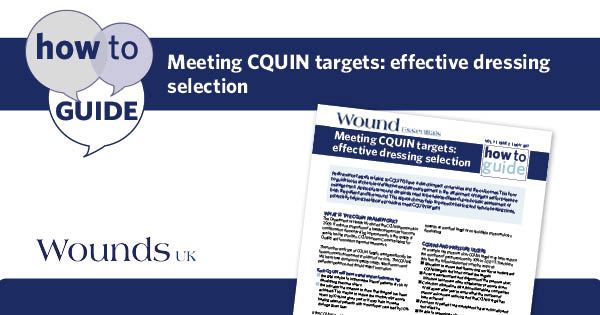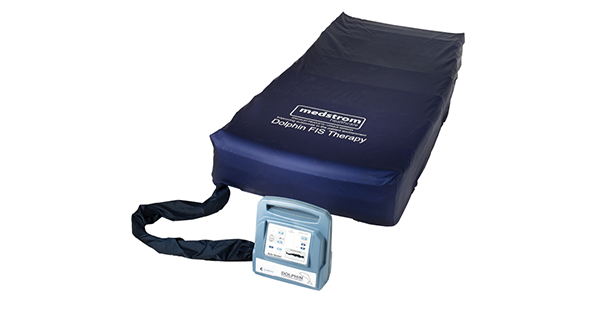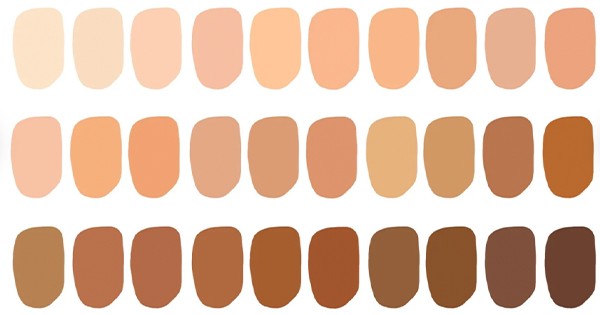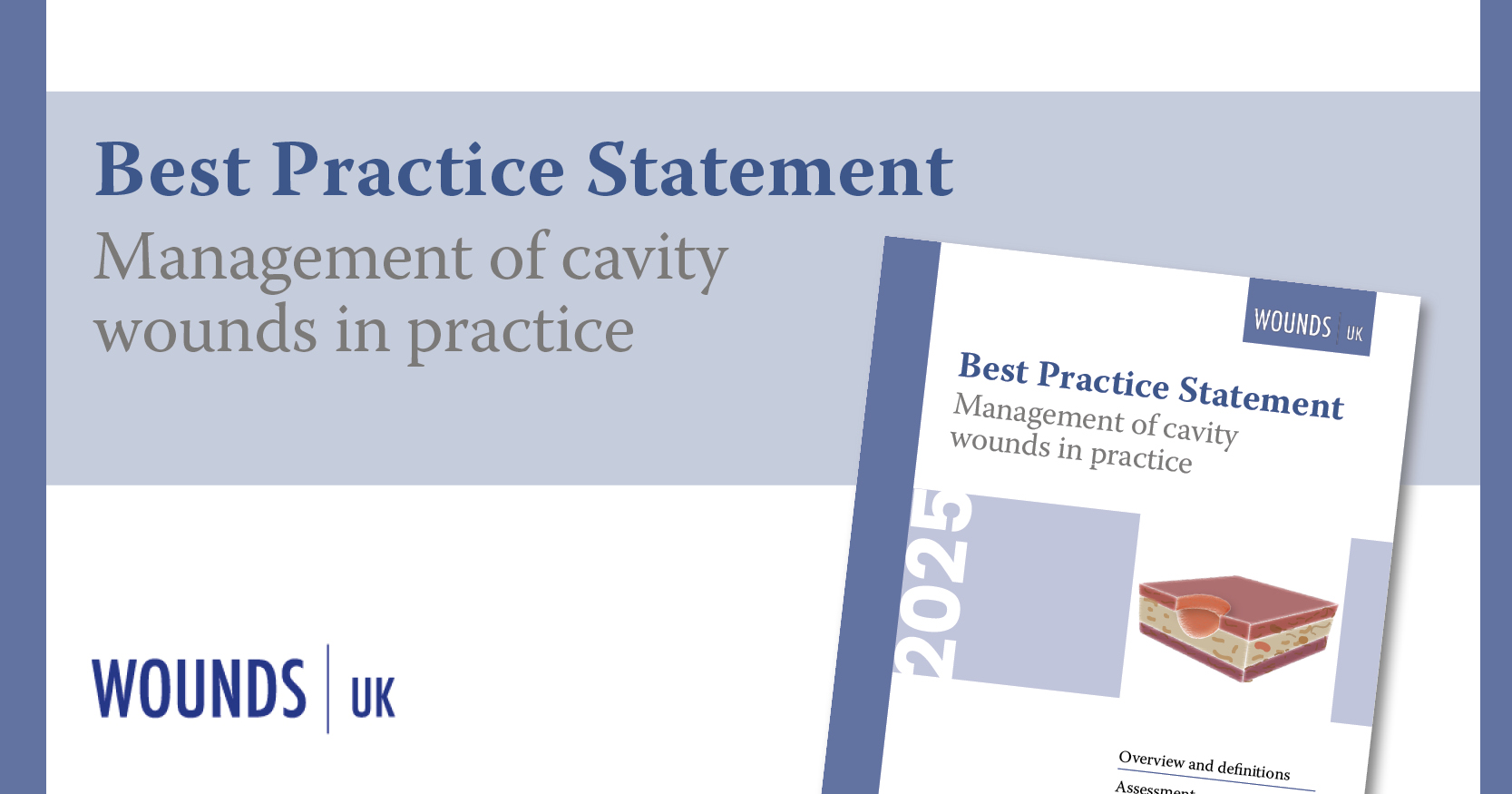Performance targets relating to CQUINS have a direct impact on services and outcomes. This how to guide looks at the role of effective exudate management in the attainment of targets set for pressure ulcer management. Appropriate wound dressings need to be selected based upon holistic assessment of both the patient and the wound. This approach may help to promote healing and reduce healing times, potentially helping healthcare providers meet CQUIN targets.
What is the CQUIN framework?
The Department of Health introduced the CQUIN framework in 2009. It makes a proportion of a healthcare service provider’s income conditional on demonstrating improvements in the quality of the service it provides. CQUIN means Commissioning for Quality and Innovation payment framework.
The number and type of CQUIN targets are agreed locally between commissioners and providers of services. The CQUINs will have three domains of quality: safety, effectiveness and patient experience, and should reflect innovation.
Each CQUIN will have a goal and an indicator, eg:
- the goal may be to improve the lives of patients at risk of developing pressure ulcers
- the indicator is a measure to show that the goal has been achieved. This may be to reduce the number of pressure ulcers by 10% in a given year or it may be to increase healing rates of patients with wounds per case load by 10% during a given year.
If the CQUIN target is achieved, the service provider will earn a CQUIN payment, which could equate to millions of pounds (DH, 2010). If the CQUIN goals are not met, this will result in a reduced income for the service provider, which will impact on the ongoing provision of services.
What do the CQUIN targets mean for nurses treating patients?
It means that all nurses, including tissue viability nurses, will have to ensure that they can prove that the service they deliver to patients is safe, effective and that the patient has a good experience in line with the CQUIN framework.
In many NHS organisations, pressure ulcer reduction has become a CQUIN target. This may be due to another initiative from the NHS Institute for Innovation and Improvement called High Impact Actions for Nursing and Midwifery. One of the eight high impact actions is called ‘Your Skin Matters’ and this recommends that there are no ‘avoidable’ pressure ulcers in NHS care (NHS Innovation and Improvement, 2009). This will drive organisations to reduce the numbers of pressure ulcers towards an eventual performance target to prevent all avoidable
pressure ulcers.
CQUINs and pressure ulcers
An example of a pressure ulcer CQUIN target may be to reduce the numbers of pressure ulcers by 10% in 2012-13. To achieve this, then the following elements may be required:
- Education to ensure that the nursing workforce understand CQUIN targets and how to meet the targets
- Accurate assessment and diagnosis of the pressure ulcer. Moisture lesions are often mistaken for pressure ulcers
- Collection of base line data, this will enable a comparison of data year on year to ensure that the numbers of pressure ulcers are reducing and the CQUIN target has been achieved
- Provision of patient treatment plans that are clinically and cost effective
- Be able to recognise a change in a patient’s wound and respond to this change in a timely manner
- Provision and monitoring of a local wound care formulary while optimising dressing use and nursing time
- Utilising specialist services and other allied health professionals.
Importance of an accurate assessment and diagnosis
If these wounds are not accurately assessed, moisture lesions could be documented as pressure ulcers (Guy, 2012). The numbers of pressure ulcers that are reported will then be elevated. This could result in an inaccurately high level of pressure ulcers being recorded, which could mean failing to meet the CQUIN target. Judicious use of a barrier cream (eg CavilonTM Durable Barrier Cream) will reduce the incidence of moisture lesions and thereby the potential for confusion with pressure ulcers.
Types of data collection required
- Pressure ulcer incidence data: Number of pressure ulcers that have developed in a given length of time and calculated as a percentage of a given population.
- Prevalence data: Number of pressure ulcers in a ward/hospital/community team on a given day (pin point in time). This should be calculated as a percentage of a given population.
Importance of dressing selection
In meeting the requirements of the quality agenda and subsequent local CQUIN target schemes, practitioners need to select the most appropriate wound dressing in order to promote wound healing, reduce the risk of infection, reduce pain, manage exudate and prevent readmission to hospital due to wound infection (Shorney and Ousey, 2011).
The impact of moisture
One of the functions of the skin is to provide a waterproof protective barrier. However, prolonged or excessive contact with moisture will cause the keratinised cells in the epidermis to swell and become waterlogged, leading to epidermal stripping and breakdown of the skin. This can have a devastating effect if the skin in this area (eg buttocks or natal cleft) is also subjected to pressure and shear, resulting in a pressure ulcer.
Management of moisture is achieved by a combination of effective protection of the skin and controlling the moisture, either with wound dressings (if the source is exudate) or continence/barrier products (if the source is body fluids).
When a pressure ulcer has developed, it is often exudate that impacts on the progression or deterioration of a patient’s pressure ulcer:
- If the exudate is healthy and well controlled, the wound bed is free from devitalised tissue and the external pressures are mediated, the pressure ulcer will have an optimum chance to progress
- If exudate is not effectively absorbed by wound dressings, especially if the exudate is chronic, this will result in deterioration of the wound bed and ultimately the depth and the size of the pressure ulcer may increase.
The control of exudate is vital. Management involves:
- Protection of the periwound skin
- Key to effective skin protection is the use of barrier products that have been clinically proven, are non-sensitising and do not leave a sticky or tacky residue after application, potentially causing continence products or bed linen to adhere to the patient. The use of barrier products should be integral to any prevention strategy for both pressure ulcers and continence dermatitis.
Effective absorbency with wound dressings
The selection of a wound dressing is dependent on the assessment of the patient’s wound including exudate levels, the surrounding skin, patient sensitivities and patient choice. One of the key objectives for dressing choice is to manage exudate effectively and prevent maceration/excoriation while maintaining a moist wound bed to facilitate healing. It is key for the nurse to be aware of the dressing’s capacity to absorb and hold onto wound exudate so that the frequency of dressing change can be determined. If the wound dressing becomes saturated the patient is at risk of maceration/excoriation (Wicks and Stephen-Haynes, 2008).
Frequency of dressing change
A dressing requires changing when it has reached capacity and/or there is strikethrough (ie the exudate is coming through the dressing, the outside of the dressing is wet or it is leaking.)
What is exudate?
Wound exudate is produced as a natural part of the wound healing process and all wounds produce exudate in varying amounts, colour and viscosity. It keeps the wound bed moist and supplies it with proteins, growth factors, white blood cells, tissue repairing cells and other essential nutrients (WUWHS, 2007).
Exudate levels will guide us to the dressing product we choose and the frequency with which we change these dressings. This in turn has an impact on the numbers of nursing hours utilised in wound care and therefore has a direct correlation to the cost of a nursing service.
Each dressing will come with the manufacturers instructions as to when it needs changing. However, saturated dressings enable bacteria to invade the wound and put the patient at risk of developing maceration or excoriation.
Effects of maceration
Maceration means that the wound edges have become overhydrated due to wound exudate not being managed effectively and the wound edges not being protected. This may be due a change in the state of the wound; for example, the wound may have become infected resulting in an increase in the exudate levels and the chosen dressing may no longer be absorbent enough, or the dressing may be too small for the wound, or just not absorbent enough.
The overhydration of the periwound skin will appear white and be friable, potentially leading to the wound becoming larger or deeper, which may progress the category of the pressure ulcer and affect the CQUIN targets.
Effects of excoriation
Excoriation is when the epidermis is stripped or eroded by enzymes in the exudate called proteases. One group of proteases is called matrix metalloproteinases (MMPs) and they have a vital role to play in debriding and cleaning devitalised tissue in a wound (Moore, 2003; Wicks, 2008). However, in some chronic wounds, these proteases become more prolific and can cause significant damage to the wound bed and periwound skin (Trudgian, 2005). Therefore effective management of exudate is essential by:
- protecting the periwound skin with barrier products
- using effective absorbent wound dressings
- changing the dressings frequently enough to prevent deterioration of the wound and surrounding skin.
Appropriate dressing selection for optimal outcomes
Foams
Most traditional foam dressings are made of a polyurethane foam. The actions of foam dressings vary in the speed in which they absorb exudate and their ability to absorb and retain exudate. Some foam dressings wick laterally and the exudate spreads across the foam. Others wick vertically and are aided by a good moisture vapour transmission rate (eg evaporation), allowing for more effective fluid handling. Consideration should also be given to how well the foam retains fluid under pressure or compression. All of these factors should be taken into account when choosing a dressing, as a foam that does not handle fluid well will put the patient’s wound at risk of maceration.
Hydrofiber® dressings and alginates
These primary dressings have varying absorption capacities depending on the product. They provide a moist wound healing environment and are generally easy to remove. They can used underneath foams or other absorbent pads to increase the levels of absorbency in a highly exuding wound.
Superabsorbent dressings
If the wound requires frequent dressing changes to manage the exudate, the level of absorbency could be stepped up to a superabsorbent dressing. These dressings also vary in their ability to absorb and retain fluid and how they function under pressure or compression. Some superabsorbent dressings are also able to lock in bacteria and proteases, which may be harmful to a wound. A superabsorbent dressing may allow for a longer time period between dressing changes, reducing nursing time and making them a cost-effective dressing choice.
Negative pressure wound therapy
If the level of exudate is still too high for either a foam or a
superabsorbent dressing to be effective, negative pressure wound therapy could be considered for exudate management. Other more pertinent reasons are its ability to promote healing and reduce healing times (Romanelli et al, 2010), also potentially helping healthcare providers meet CQUIN targets.
ACHIEVING BETTER OUTCOMES
The accurate assessment and diagnosis of wounds will have a direct financial impact on healthcare providers. More specifically, the correct diagnosis of pressure ulcers could ensure that CQUIN targets are met and the quality of care provided to patients can be proven by the reduction in the numbers of pressure ulcers. Furthermore, each organisation has to strive to have zero avoidable pressure ulcers to meet the recommendations by the NHS Institute of Innovation and Improvement (2009).
The correct choice of dressings will also have an effect, not only on patient outcomes, but on healing rates, nursing time and dressing budgets. Choice therefore has further financial implications for any healthcare provider when wound care is connected to targets.
It is clear that the government is concentrating on the quality agenda for the NHS and it is the responsibility of nurses at all levels to ensure that the targets and innovations are met. If they are not met, the financial implications will affect us all. Understanding the bigger picture and the consequences of our actions can help us achieve better outcomes for our patients and for all NHS providers of care.
References
- Department of Health (2010) Using the Commissioning for Quality and Innovation (CQUIN) payment framework – a summary guide. DH, London
- Guy H (2012) The difference between pressure ulcers and moisture lesions. Wounds Essentials 1: 36-44. Available from: https://wounds-uk.com/pdf/content_10448.pdf
- National Nurse Sensitive Outcome Indicators for the NHS and commissioned care (2010) http://www.ic.nhs.uk/webfiles/Services/Clinical%20Innovation%20Metrics/NSOI_Indicators_Version_3_FINAL.PDF
- NHS Institution for Innovation and Improvement (2009) High impact actions for Nursing and Midwifery. NHS Institution for Innovation and Improvement, Coventry. Available on line at: www.institute.nhs.uk
- Romanelli M, Vowden K, Weir D (2010) Exudate management made easy. Wounds International 1(2). Available from: http://www.woundsinternational.com/pdf/content_8812.pdf
- Shorney R, Ousey K (2011) Tissue viability: the QIPP challenge. Clin Services J 6-9
- Trudgian J (2005) Exudate management and wound bed preparation: taking the MOIST approach. Wounds UK supplement 1(2) 10-15
- Wicks G, Stephen-Haynes J (2008) Wet wounds: practical steps to improving active fluid management Br J Community Nurs 13 (6) (Suppl)
- WUWHS (2007) Wound exudate and the role of dressings. A consensus document. London: MEP Ltd. Available from: www.woundsinternational.com
Author: Gill Wicks, Consultant Nurse, Tissue Viability, Great Western Hospitals NHS Foundation Trust, Trowbridge, Wilts
Supported by 3M Health Care







